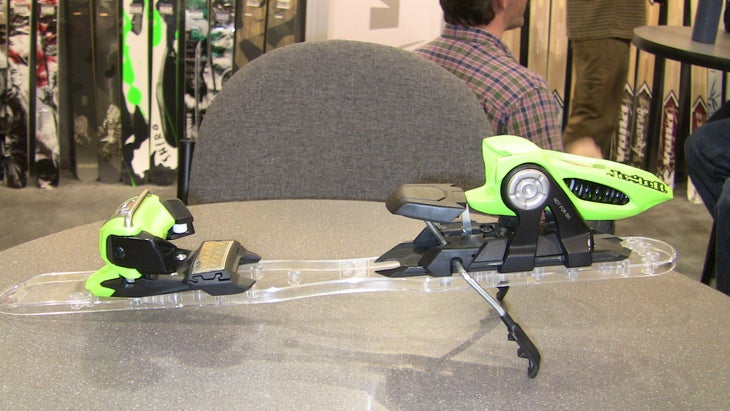Heading out the door? Read this article on the new Outside+ app available now on iOS devices for members! Download the app.
Editor’s Note: SKI Magazine recommends only having your bindings adjusted by a certified professional at your local ski shop. DO NOT adjust your ski bindings yourself. The following article is meant to be informative. Ask a ski tech for more information.
It seems like there is nothing more humiliating than hearing, “Yard sale!” from the lift as you tumble down the mountain, skis and poles flying in every direction. But, if you fail to release properly from your skis, the same fall could result in an even more humiliating trip via ski patrol sled. The difference comes down to the DIN setting of your binding.
That setting is the number a ski shop figures out after you lie about your weight, your height and your skier ability. But really, it’s two calculated numbers that signify how much forward falling force and twisting force will release you from your bindings. Besides weight, height and skiing ability, the number is based on your age and boot-sole length.
What is DIN?
DIN (Deutsches Institut für Normung), a German institute for standardization, originally set the standards, and, currently, the International Organization for Standardization (ISO) publishes the information.
“It puts it into black and white, for all manufacturers, what the loads are and the tolerance of the loads at which the bindings have to release at to pass safety standards,” says Cameron Shute, G3’s senior product development engineer.
It’s that safety aspect that pushes most skiers to a qualified ski shop in order to have bindings set correctly.

“Ski shops have the equipment to test that your binding is working correctly,” says Geoff Curtis, Marker’s marketing vice president.
A chart matches your height and weight with a release code, a letter A through O. The code is then adjusted for skier type (a higher DIN for a more advanced skier) and age (a lower setting if the skier is younger than 9 or older than 50 to accommodate the higher risk of tibia fractures in these two age groups).
Ski shop employees and other trained ski-industry pros ensure that your bindings will release with the appropriate amount of torque. Erik Anderson, winter sports sales director for Atomic and Salomon, says you should buy bindings that correspond with your skill level and aggressiveness.
“Some bindings are designed primarily with release in mind, while others are designed more for retention,” he says.
Check out and purchase the latest Marker Jester Pro on Amazon
How often should I have my ski bindings tested?
It’s not just a set-it-and-forget-it scenario.
“If anything about the parameters of height, weight, or boot length change, you will want to have [your ski bindings] re-evaluated,” Curtis says.
There is not much wiggle room—only 10 percent of the setting—which is equivalent to the average man twisting out of his binding 0.134 mph faster or slower.
“It’s very specific,” says Anderson. “Within a setting, we expect the boot sole to release within a certain torque range.”
The average beginner male will release from his bindings at a DIN setting of 6 or between 194 to 271 Nm of torque, while the average advanced male will release from his bindings at a setting of 8.5 between 271 and 380 Nm.
And though the majority of tech bindings aren’t DIN certified, there’s not much difference in when they release. Alpine and tech bindings should release at the same load if they have the same DIN (or DIN-equivalent) setting, but alpine bindings have a higher capacity to absorb energy, Shute says. They are built for hard snow at resorts, whereas tech bindings are built for light, backcountry powder.
Somewhere between tech and alpine: Binding Hybrids
“When the snow is soft, the binding helps absorb energy,” Shute says. “So you can get away with a lower release setting.”
But take into account: if you’re carrying a backpack, you may need a higher DIN setting. Those snacks, that shovel, probe, and beacon count as part of your weight.
Overall, to save yourself from that toboggan ride or a fractured shinbone, make sure your bindings are set correctly.
Originally published in February 2014. Links and photos updated April 2020.